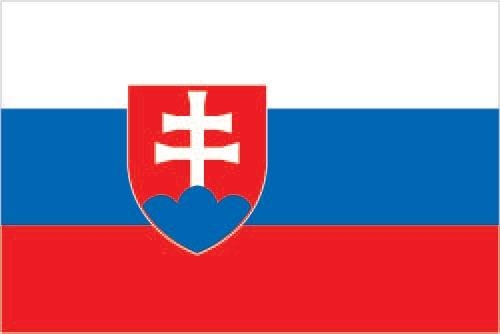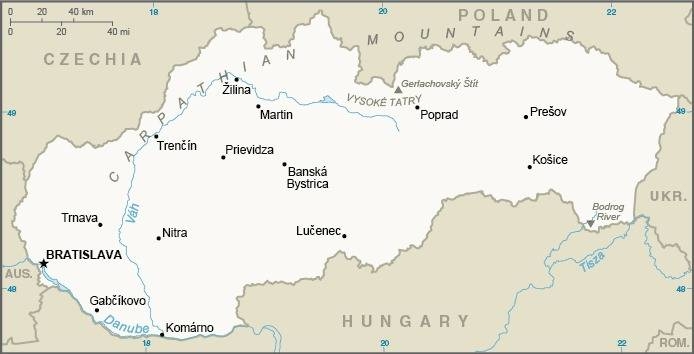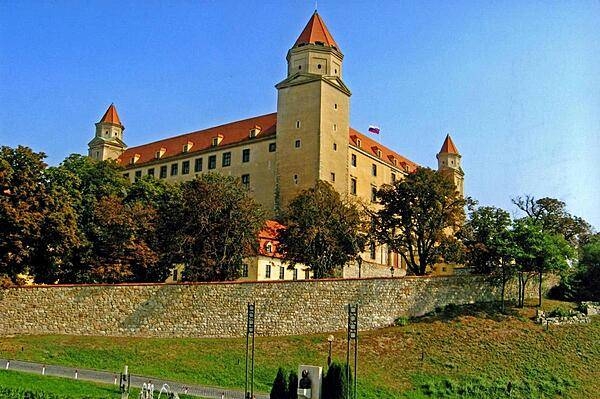108 Slovakia

Three equal horizontal bands of white (top), blue, and red derive from the Pan-Slav colors. The Slovakian coat of arms (consisting of a red shield bordered in white and bearing a white double-barred cross of St. Cyril and St. Methodius surmounting three blue hills) is centered over the bands but offset slightly to the hoist side.
Flag courtesy of the CIA World Factbook

Map courtesy of the CIA World Factbook

Bratislava Castle is one of the most prominent structures in its namesake city. The exterior was recently repainted a white color.
Photo courtesy of the CIA World Factbook
Government
According to Britannica, the Slovak National Council adopted a new constitution for the republic on September 1, 1992, four months before the partition of the federation. In general philosophy, this document, like its Czech counterpart, reflects the Charter of Fundamental Rights and Freedoms passed by the former Czechoslovak Federal Assembly in 1991. The constitution provides for a unicameral legislature (the National Council), consisting of deputies chosen by direct general election. The head of state, the president, is elected for a five-year term. The 1992 constitution specified that the president was to be elected by a three-fifths majority of the National Council; however, in 1999 the government approved a constitutional amendment that changed the procedure so that subsequent presidents would be directly elected. The supreme executive body of the republic is the government formed by the prime minister, whom the president appoints. The prime minister is usually the leader of the majority party or coalition in the National Council.
The constitution addresses the issue of local administration only cursorily, defining the single unit of municipality as a territorial and administrative entity exercising jurisdiction over its permanent residents. Actually, Slovakia is composed of eight administrative regions (including Greater Bratislava), with each region divided into a number of districts. In March 1996 the Mečiar government implemented a new scheme of local governments that resulted in a redrawing of the political borders of many southern districts, with borders running from north (where the population is solidly Slovak) to south. The ultimate aim of this reconfiguration was transparent: to reduce the number of ethnic Hungarians elected to the municipal and district councils. However, the reconfiguration of 15 existing southern districts and the creation of 37 new ones did not substantially change the ethnic balance in the southern councils, as was shown in subsequent elections. Mečiar’s other attempt to introduce ethnic quotas in municipal elections procedures in 1998 was turned down by the Constitutional Court.
The apex of the Slovak judicial system is the Supreme Court, to which district and regional courts are subordinated. The Constitutional Court, comprising a panel of judges appointed by the president, occupies a special position, as it deals with matters arising from the constitution and the application of international treaties. The lower courts of justice resolve civil and criminal matters and assess the legality of administrative rulings. Slovakia’s civil law code is based on Austro-Hungarian codes, as amended after 1918 and 1945, but has been revised to eliminate language dating from the communist era and to comply with requirements set by the Organization for Security and Co-operation in Europe.
Transport Authority
Transport Authority was established by the Act No. 402/2013 Coll. on Regulatory Authority for Electronic Communications and Postal Services and on Transport Authority and on amendments of several acts, coming into force on 1 January 2014 as a state administrative body with nationwide competence in the area of railways and other guided transport, civil aviation and inland waterway transport.
Airspace
SkyVector – Google Maps – ADS-B Exchange
ICAO countries publish an Aeronautical Information Publication (AIP). This document is divided into three parts: General (GEN), En Route (ENR) and Aerodromes (AD). ENR 1.4 details the types of airspace classes they chose to adopt from classes A through G.
Drone Regulations
Drone Laws – infographic
Online aeronautical chart of the Slovak Republic
Advanced Air Mobility (AAM) Regulations & Policies
Bilateral agreements facilitate the reciprocal airworthiness certification of civil aeronautical products imported/exported between two signatory countries. A Bilateral Airworthiness Agreement (BAA) or Bilateral Aviation Safety Agreement (BASA) with Implementation Procedures for Airworthiness (IPA) provides for airworthiness technical cooperation between the FAA and its counterpart civil aviation authorities.
Reciprocal acceptance of aviation safety-related approvals and services with the European Union Aviation Safety Agency (EASA) and Member States of the European Union are primarily governed by the U.S. – European Union Safety Agreement.
Advanced Air Mobility (AAM) News
Short Essay Questions
Scenario-Based Question
You have been hired by a Drone Startup Company. Your boss has immediately assigned this job to you.
They need you to prepare a one-page memo detailing the legalities of using a drone to film the castle in Bratislava, pictured above.
They need you to mention any national laws and local ordinances.
They specifically want to know what airspace (insert pictures) you will be operating in and whether or not you need an airspace authorization.
Does it matter whether or not you are a citizen of the country?
Lastly, there is a bonus for you if, as you scroll through this chapter, you find any typos or broken links!
Short Essay Questions
- What are the drone categories?
- How is registration addressed?
- How is remote ID addressed?
- What are the model aircraft rules?
- What are the commercial drone rules?
- Are there waivers or exemptions to the rules? If so, for what?
- Would you share a link to an interactive airspace map?
- How is BVLOS addressed?
- How can you fly drones at night?
- How can you fly drones over people?
- Where do you find drone NOTAMs?
- What are the rules for drone maintenance?
- What are the rules for an SMS program?
- What are some unique rules not mentioned above?
- What are the C-UAS rules?
- What are the AAM rules?

